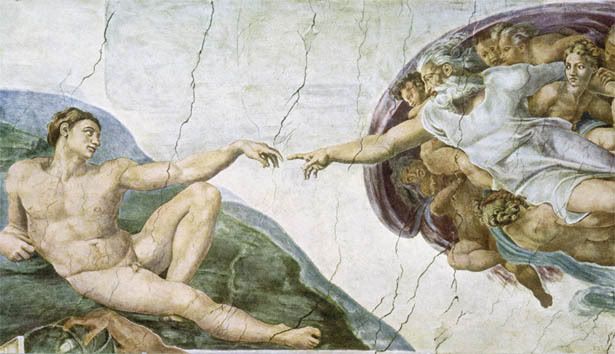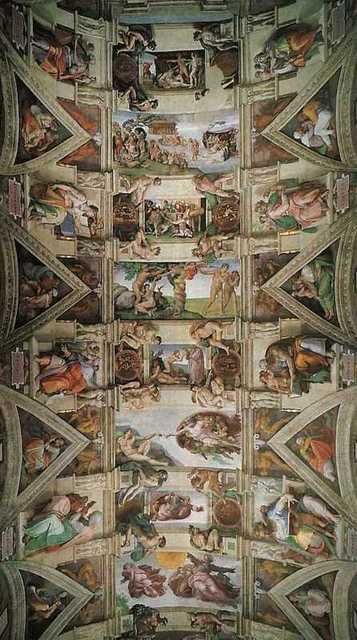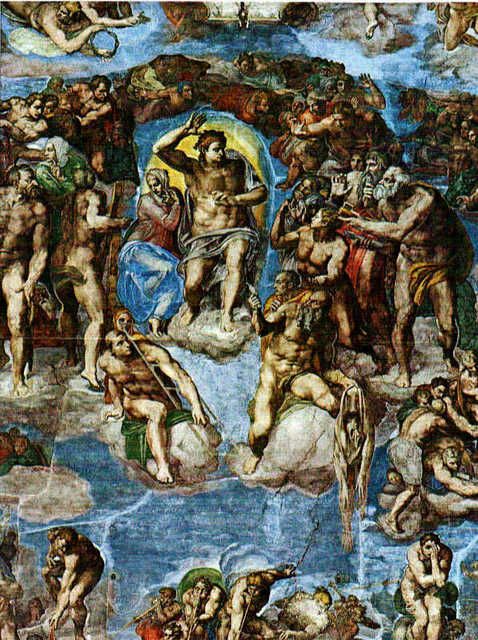It took Michelangelo four years to paint the Sistine Chapel ceiling and five years to paint its altar. Between those two jobs he took a twenty-eight year break. It is because of this break that the two works, the ceiling and the Last Judgment look as if two different artists completed them.
Michelangelo started the ceiling in 1508. His idea was to paint scenes from the Bible in the order of how they are told. Beginning with God Separating Light from Darkness to the Drunkenness of Noah. Michelangelo’s painting techniques stayed fairly similar. In general the ceiling looks as if he could have finished it in a week. All the scenes, though some painted four years apart, are painted in the same style that Florentine humanism inspired in Michelangelo. These painted bodies followed in the tradition of Michelangelo’s sculpture of David (sculpted from 1500 to 1504) which was possibly inspired by the classical statue of the Apollo Belvedere. this means that the male nudes are beautiful, heroic, realistic representations of the male body.

And as a whole the Sistine ceiling has a very orderly feel to it. All the different scenes are framed by “illusionistic marble architecture” (Stockstad 696) that separates all the stories from each other.

When Michelangelo returned to paint the altar it was after a period of many violent political and religious events, including the Protestant Reformation. The earlier idea of united one big church under Catholic order fell apart. Devotions to saints and religious images were destroyed and, in Northern Europe, entire churches were white washed by vandals. Because of this, the very authority of art was called into question. As an artist Michelangelo was very affected by this idea, and the altar reflects the change which took place within his own work as a response.

While the stories on the ceiling are mostly uplifting images, the story and the images on the altar are mostly of tragedy, despair and pain. Where those differences are best represented are in the ways Michelangelo depicted the human body. The bodies on the ceiling follow the idea of heroic male bodes that look beautiful, virile and virtuous, the ones behind the alter do not. They resemble the male nude body in the ancient statue of the Laocoon that was discovered a couple of years before Michelangelo started work on the ceiling. (He would have, in all likelihood, had knowledge of this statue as it was in the Vatican collection of Julius II.) These types of nude male figures look as if they are on steroids. They are bulky, the muscles look harder and over-defined, a more idealized version of the male body. Because of the pain that most of the men are feeling their bodies are in poses that look distorted, in order to outwardly represent their inner turmoil.
 detail from altar
detail from altar  detail from ceiling
detail from ceilingThe images on the ceiling had a feeling of order and containment with the frames around each other; Michelangelo does away with the frames on the alter, thus creating a chaotic mass of bodies against bodies. On the ceiling the bodies had a very normal relation to space and to each other, Michelangelo ignores that on the altar because the bodies are supposed to be falling through space and for that reason there, logically, is not really a “normal” way for the human body to conform or react.
Michelangelo was responding to the frustrations and disenchantment of the people of the Catholic Church in a period of upheaval. His altar mirrored the Laocoon that became the violent substitute for the Apollo Belvedere as a representation of the mid-century struggle of human beings in response to their own deaths by the outside forces with wars, revolts and reformations. With all these social changes it is no wonder that Michelangelo’s two works would look so different. An artist’s work is very influenced by the world around him and his responses to it.
Copyright 2003 Megan Tharpe

